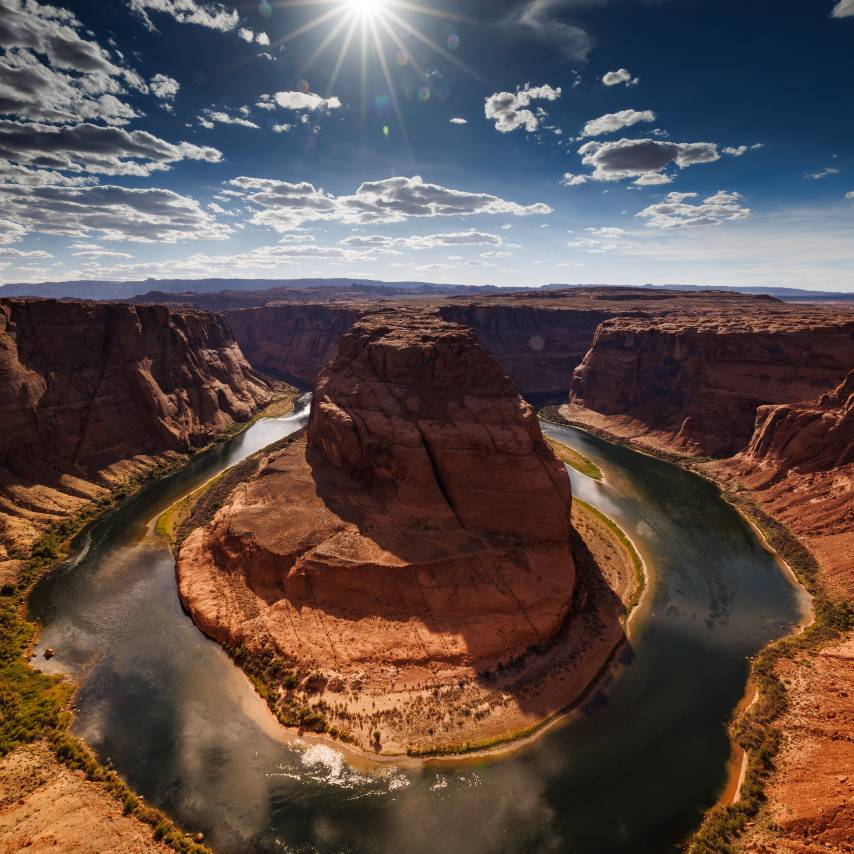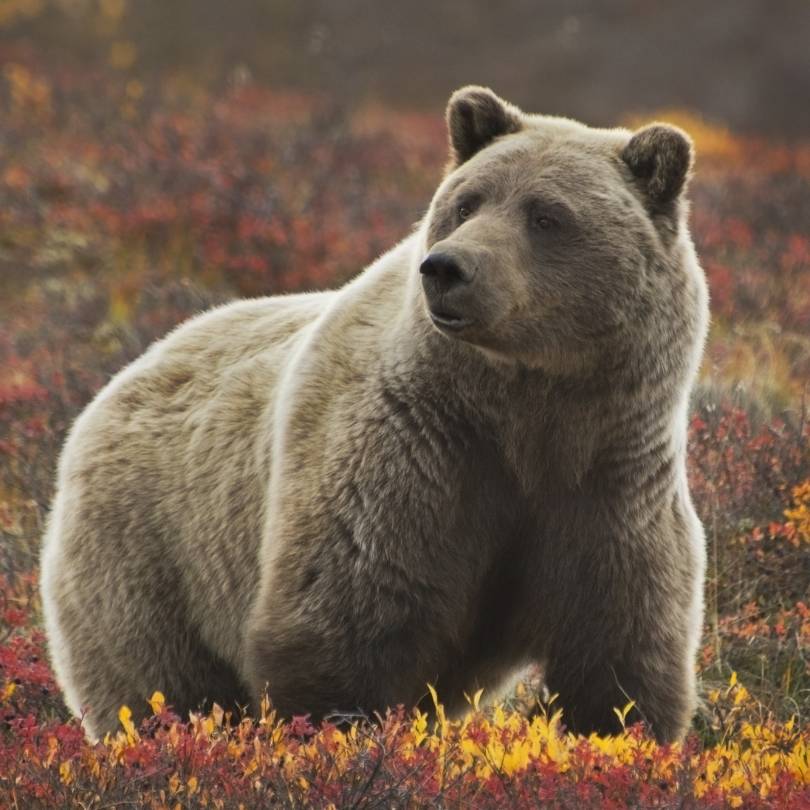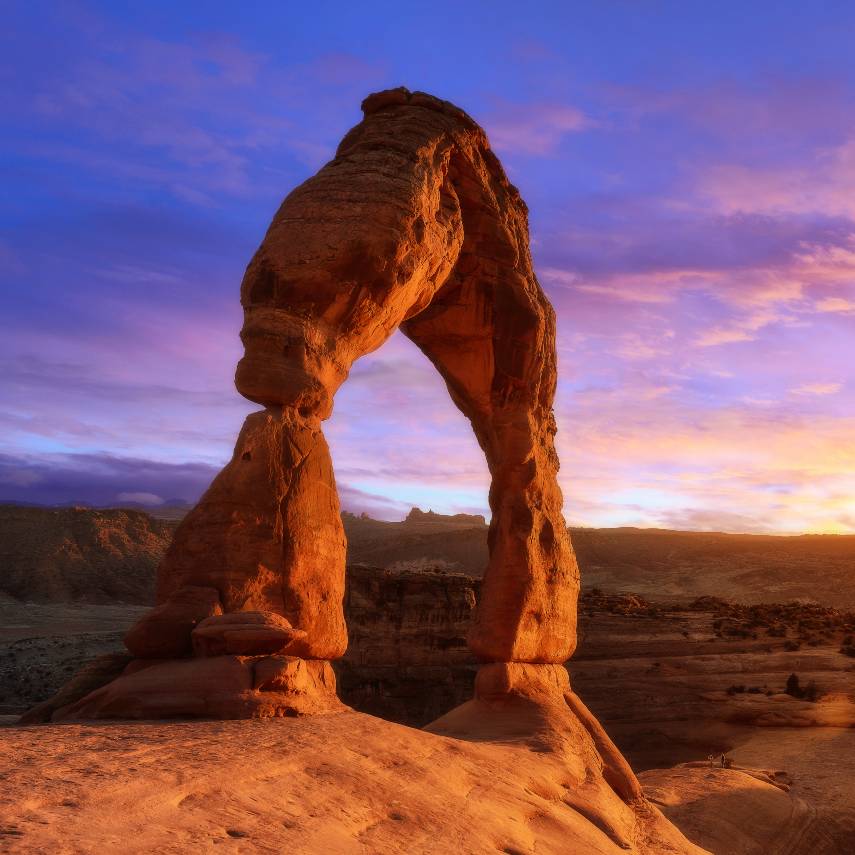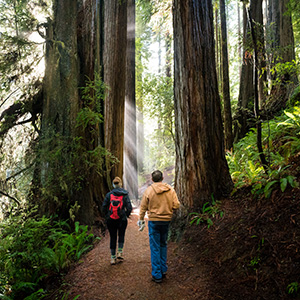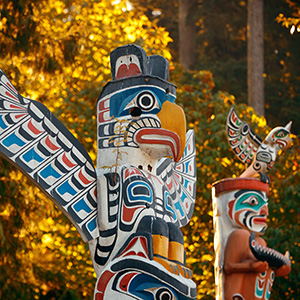Highlights of USA & Canada DMC

Grand Canyon NP and the American Southwest
Grand Canyon National Park must be seen to be believed. This mile-deep canyon carved by the Colorado River reveals almost two billion years of geologic history and a multitude of ever-changing colors. Travel along the rim to enjoy different perspectives as light and shadow move through the canyon. Watch for elk in the ponderosa pines, or endangered California condors soaring high above the Colorado River.
Sedona is rich with history, culture, spirituality, and recreation. Explore the red rock landscape by foot or by Jeep or learn about Native American culture at a local cliff dwelling. After a day of roaming Sedona’s cliffs and canyons, enjoy a varied and upscale dining scene while watching the sun go down.
Scottsdale has long been Arizona’s luxury oasis: best-in-class lodging, dining, shopping, and golf in the Sonoran Desert. Scottsdale is equally famous for nature and culture, and desert adventures compete for your time with galleries, art, and nightlife. Cradled in the Sonoran Desert, Tucson’s deep-rooted history blends diverse culture with breathtaking natural beauty.
The adventure hub of Moab lies at the heart of Southeast Utah’s canyon country. Blessed with a lively local arts scene, endless activities and two national parks, Moab may be the highlight of your journey. Arches National Park is the main draw, but rafting the Colorado River comes in a close second. After a day of exploration, relax and enjoy a red rock sunset.
Lake Powell’s beauty comes from the striking contrast between water and stone. Deep blue water meets sheer sandstone walls in the middle of the desert. Explore twisting slot canyons by boat or by foot or paddle the calm waters in a kayak. The nearby attractions of Horseshoe Bend and Antelope Canyon also beckon.
Las Vegas looms large in American culture and travel. There’s much more to this city than cards and dice: modern Las Vegas sparkles with spectacular attractions such as the new Sphere, top-tier entertainment, accommodations, shopping, and restaurants. Enjoy Michelin-caliber dining before a Cirque du Soleil show or world-famous musical act.
Santa Fe is an enchanting blend of history, culture, food and art. Founded in 1610, Santa Fe retains an historic character through the adobe architecture of the old downtown. Artists have long been drawn to the clear air of the high desert, and today you can stroll Canyon Road, browsing galleries in one of the largest art markets in the country. Numerous museums and nearby pueblos provide a window into New Mexican culture, while a top-notch dining scene features the state’s famous chiles.

Alaska: America's 49th State and the 'Last Frontier'
Anchorage is a delightful blend of urban parks and museums, while the nearby Chugach Mountains are a gateway to adventure. Despite Alaska’s reputation for wilderness and wildlife, modern Anchorage has much to offer. Cultural experiences in the city include the Alaska Native Heritage Center, Anchorage Museum, art galleries, and restaurants featuring fresh local seafood.
Mt. Denali is the highest peak on the North American continent and the centerpiece of Denali National Park and Preserve. Its summit rises to 20,320 feet above sea level. Enter a world of snow-capped mountains and glacier-filled valleys via a flightseeing excursion to gaze upon the south and east faces of Denali from the air. See towering Ruth Glacier and the mile-high granite walls of the Great Gorge.
The Kenai Peninsula, just an hour south of Anchorage, faetures classic Kenai landscapes such as snow-capped mountains, turquoise rivers, and stunning, glacier-filled fjords with marine animals, from orca, humpback whales and eagles to sealions and puffins. Fish for salmon, take a wildlife cruise or hike through an alpine meadow. There’s a reason why locals call the Kenai Peninsula Alaska’s Playground.
The most visited locales in the vast Southeastern section of Alaska are Ketchikan, Sitka, and Juneau. The crown jewel of the region is Glacier Bay National Park and Preserve, with its soaring glaciers, and the entire region provides habitats for bears, mountain goats, wolves, whales, and eagles. This is a world of steep-shouldered islands, cliff-rimmed fjords, snowcapped peaks, and majestic glaciers.
The Alaska Backcountry caters to adventurous travelers who seek to experience more primitive Alaska. Travel by floatplane or boat to off-road backcountry lodges. Our travel planners will match your interests – wildlife viewing, adventurous activities, fishing, Northern Lights, winter sports, or a combination – to the perfect lodge.
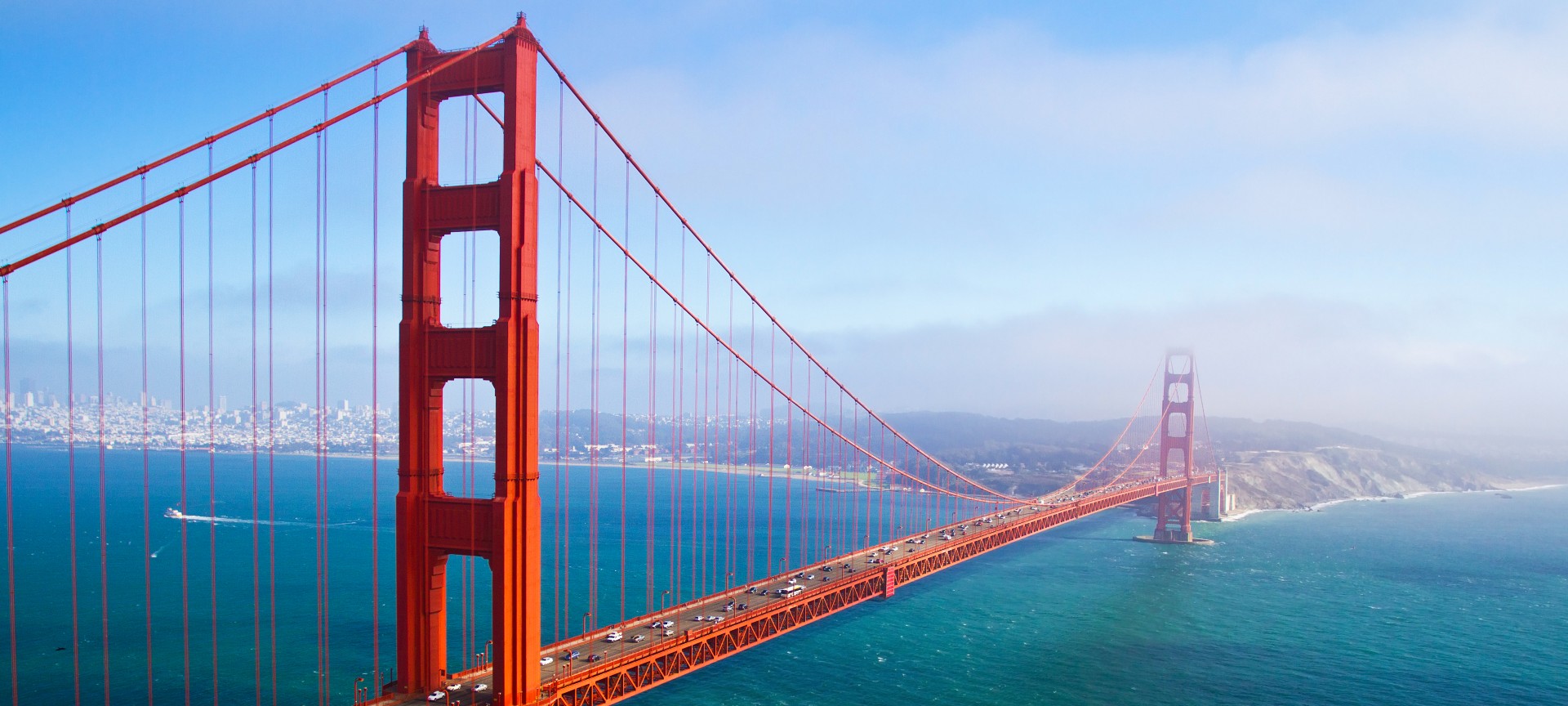
San Francisco & Napa/Sonoma Wine Country
Eclectic, colorful, historic and avant-garde - San Francisco is a lively city with a little something for everyone. From famous sights, including the Golden Gate Bridge, Fisherman's Wharf and Alcatraz Island to legendary neighborhoods like North Beach, Chinatown and Haight-Ashbury, the City by the Bay appeals at every turn. Visitors come from around the world to stroll its fog-draped hills, ride its iconic cable cars and marvel at its well-preserved Victorian architecture. Highly regarded for its superb dining, especially seafood, San Francisco is also noted for its central role in groundbreaking cultural and artistic movements, including the Beat Generation of the 1950s, the psychedelic rock music scene of the 1960s, and the gay rights milestones of the 1970s and beyond. With a story that stretches from the Barbary Coast to the Silicon Valley, San Francisco welcomes travellers with an almost magical vibe.
In California's premier wine region, the abundance of food, wine, and nature delivers the perfect 'blend'. While there are plenty of trendy wineries and in-town tasting rooms, discovering and experiencing 'hidden gem' wineries, cafes, galleries and more along country roads is perhaps even more satisfying, especially when paired with gourmet picnic fare. Iconic small town charm along with stellar hotels, inns, and spas abound in Calistoga, Yountville, St. Helena, Healdsburg, and Sonoma. Napa County and Sonoma County boast over over 1,000 wineries and the region is blessed with many parks, miles hiking trails, dozens of golf courses, and hundreds of dining options, from food trucks to casual roadside cafes to Michelin-starred restaurants.
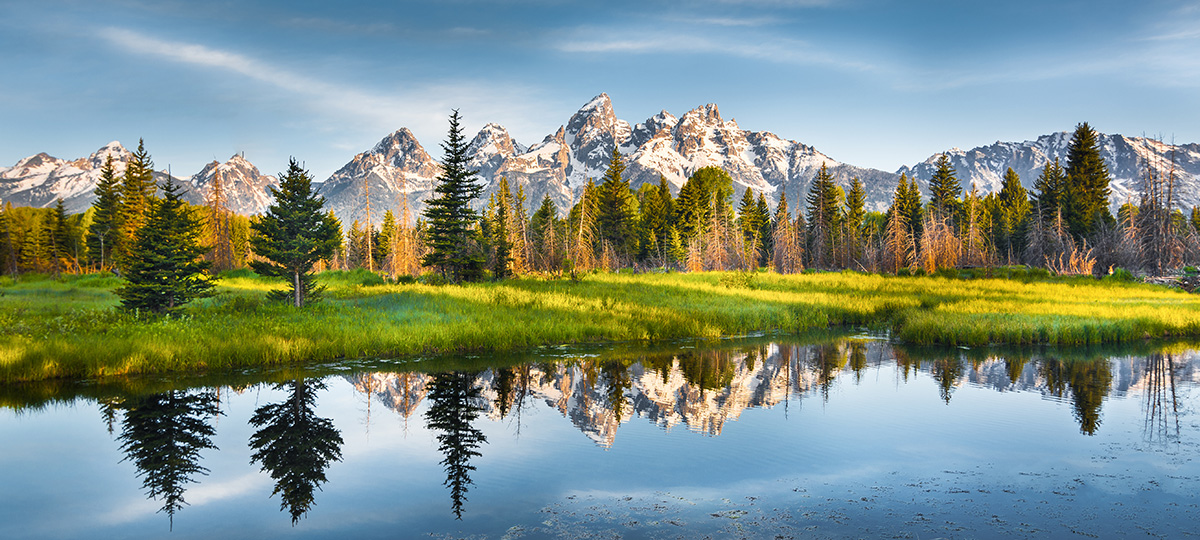
Yellowstone & Grand Teton National Parks and Jackson Hole
Yellowstone National Park comprises the largest intact ecosystem in the US. Wolves, bison, bears, elk, and moose all roam the world’s first national park, created in 1872. Hydrothermal wonders like geysers and hot pools vie with wildlife for your attention, as you explore forests, valleys, and mountains. This vast wilderness boasts the greatest concentrations of wildlife in North America. The park's geothermal features—including the geyser basins around iconic Old Faithful and the western half of Yellowstone Lake—are amazing; a testament to the still very active supervolcano whose massive eruptions over the past two million years created Yellowstone's otherworldly landscape. Other must-see attractions include the waterfalls at Grand Canyon of the Yellowstone, Mammoth Hot Springs, and Lamar Valley. The park is spectacular in winter, with snow providing a backdrop for sublime wildlife viewing.
Jackson Hole was named for the high valley where mountain men gathered beside the Teton Range in the early 1800s. These days, tent camps and ranches have largely been replaced by galleries and fine dining in the town of Jackson. The identity of modern Jackson is tied to neighboring Grand Teton National Park, where wildlife watchers, climbers and hikers pursue their passions. The park is also ideal for safari-style wildlife tours, biking, photography, and canoeing—set against the backdrop of the Snake River, numerous lakes and streams, and the Grand Teton range that tower up to 13,000 in elevation. Other top attractions in the park include Jenny Lake, Inspiration Point, and the Laurance S. Rockefeller Preserve.
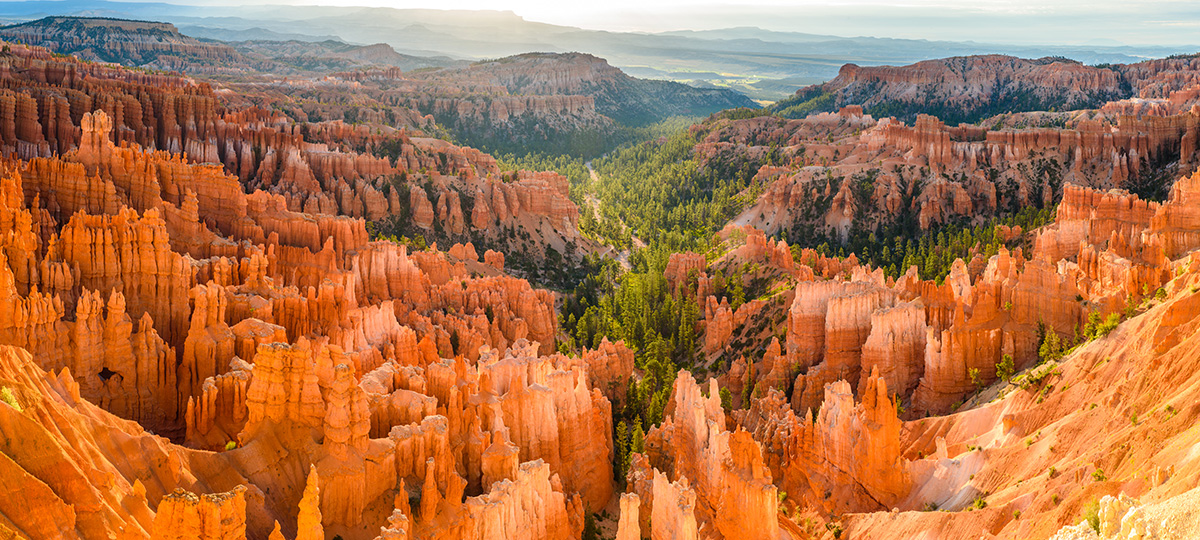
Utah’s ‘Mighty Five’ National Parks
Bryce Canyon National Park's otherworldly landscape comprises horseshoe-shaped amphitheaters with its whimsical formations of limestone rock, created by erosion and rain. enchant visitors to explore the slot canyons, windows, fins and, most notably, the tall, skinny spires called hoodoos; the park has more hoodoos than any other place in the world. With elevations reaching over 9,000 feet, Bryce offers about 150 miles of visibility on a clear day. Recognized as an International Dark Sky Park, Bryce has some of the clearest air and widest vistas in the country. Trails weaving through the natural rock amphitheater can be explored by foot, horseback, or through the lens of your camera.
Early Mormon travelers were dazzled by the red rock landscape in what is now Capitol Reef National Park, and this unique part of southern Utah continues to amaze visitors today. Travel though slot canyons and lift your eyes to rugged cliffs capped by smooth white domes of Navajo sandstone. The park offers culture as well, from petroglyphs to historic orchards that still bear fruit.
Zion National Park is a geological wonder, where water and sand meet to form one of the the most dramatic landscapes in the country. Hiking definitely tops the to-do list, and Angels Landing and the Narrows are two hikes that attract most people to Zion National Park. But there are many more trails to choose from…hikes that range from short, easy strolls to full day adventures. Watch the sandstone cliffs of Zion National Park catch fire in the sun, before setting out to explore this unique desert ecosystem. Slot canyons, shady alcoves, and hanging gardens line the walls of Zion Canyon in the heart of the park.
The red rock formations of Arches National Park feel timeless, dream-like, and perhaps other-worldly. The park has over 2,000 sandstone arches, the largest collection in the world. Arches, towers, pinnacles, and balanced rock form living art that frame horizons, cast precious shade and shadows, and are in a perpetual state of gradual transformation due to constant erosion. Fancifully named attractions like Three Penguins, Queen Nefertiti, and Tower of Babel beckon visitors to stop and marvel. The park is especially worthwhile visiting as the sun goes down. At sunset, the rock formations glow, with photographers poised to capture the magnificent rays that descend on iconic Delicate Arch and other popular sites.
Canyonlands National Park is often overlooked which is a shame. It is home to an immense expanse of deep orange-red canyons and a wonderful array of stunning red rock formations, and offers great opportunities for hiking, mountain biking, 4WD adventuring and whitewater rafting. It is Utah’s largest national park, stretching over 527 square miles of a desert landscape and rocky terrain. The park preserves the canyons, buttes, mesas, and arches that have been carved out by the Colorado and Green Rivers. It also contains the rock art of the Ancient Puebloan peoples. From the overlooks on Island in the Sky, enjoy sweeping views across the rugged desert landscapes. Journey below the mesa for an epic scenic drive on the White Rim Road. Canyonlands is adjacent to Arches National Park and the gateway town of Moab.
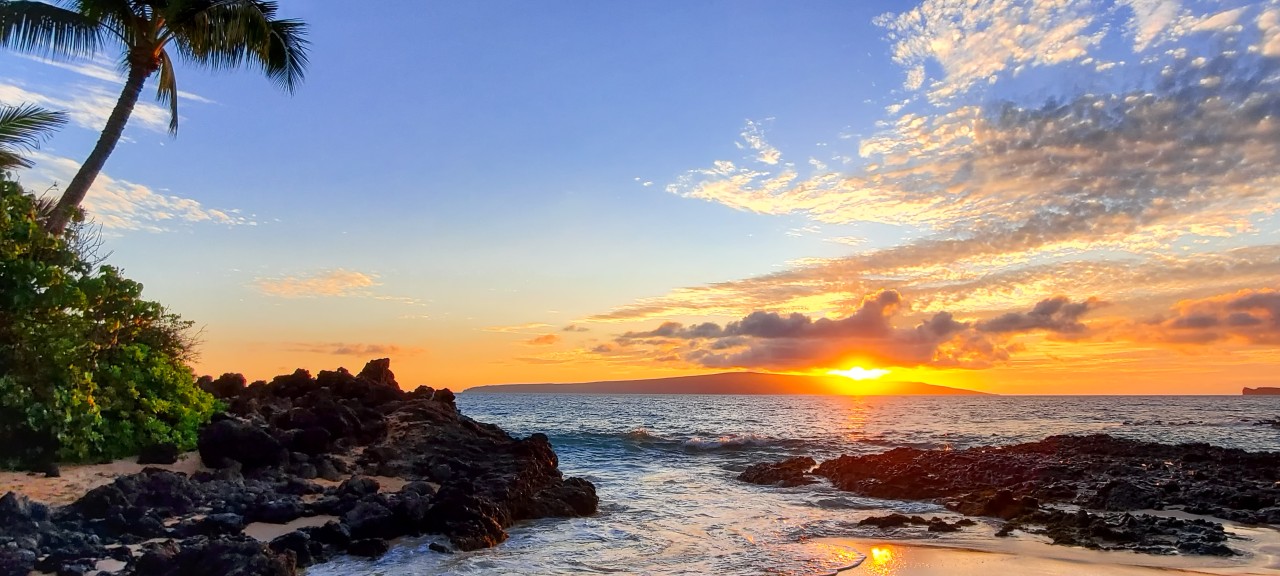
Hawaii - the Aloha State
Hawaii is a land of great diversity, beauty, and many contradictions. The animating spirit of Aloha, the rich culture of the people, and the sacred and historical traditions passed down for generations continue to define these isolated islands. A favorite getaway for travelers from all over the world, Hawai'i is justly famous for its miles of beaches, erupting volcanoes, lush rainforests, exquisite food, and exotic flora and fauna.
The island of Hawaiʻi is the youngest and largest island in the Hawaiian chain. Nearly twice as big as all of the other Hawaiian Islands combined (thus, its nickname, “the Big Island”). From the many geological features at Hawaiʻi Volcanoes National Park to the snow-capped heights of Maunakea; from the lush valleys of the Hilo and Hāmākua Coasts to the jet-black sands of Punaluʻu Beach, the island of Hawaiʻi is an unrivaled expression of the power of nature.
Kauaʻi is Hawaiʻi's fourth largest island and often called the "Garden Island," an entirely accurate description. The oldest and northernmost island in the Hawaiian chain is draped in emerald valleys, sharp mountain spires and jagged cliffs aged by time and the elements. Centuries of growth have formed tropical rainforests, forking rivers and cascading waterfalls! Some parts of Kauaʻi are only accessible by sea or air. More than just dramatic beauty, the island is home to a variety of outdoor activities, including snorkeling, kayaking, hiking, and ziplining. But what makes it truly timeless Kauaʻi is the island's laid-back atmosphere and rich culture found in its small towns.
For decades, Maui has been a favorite tourist destination with its beautiful coastal views, towering volcanoes, and open spaces free from development. It combines some of the best food, shopping, and entertainment choices from several of the other Hawaiian islands while emphasizing outdoor fun. The 10,000+ foot volcano Haleakala, combined with the incredible coastline views along the Road to Hana, and unique places like the 'Iao Valley and Wai'anapanapa Black Sand Beach make Maui a unique and special place to visit.
The August 2023 wildfires resulted in the devastating loss of loved ones, homes, cultural and historical sites, and businesses in Lahaina, located in West Maui. Respectful travel to any of the Hawaiian Islands, including Maui, is welcomed and encouraged. With the exception of Lahaina, Maui is open.
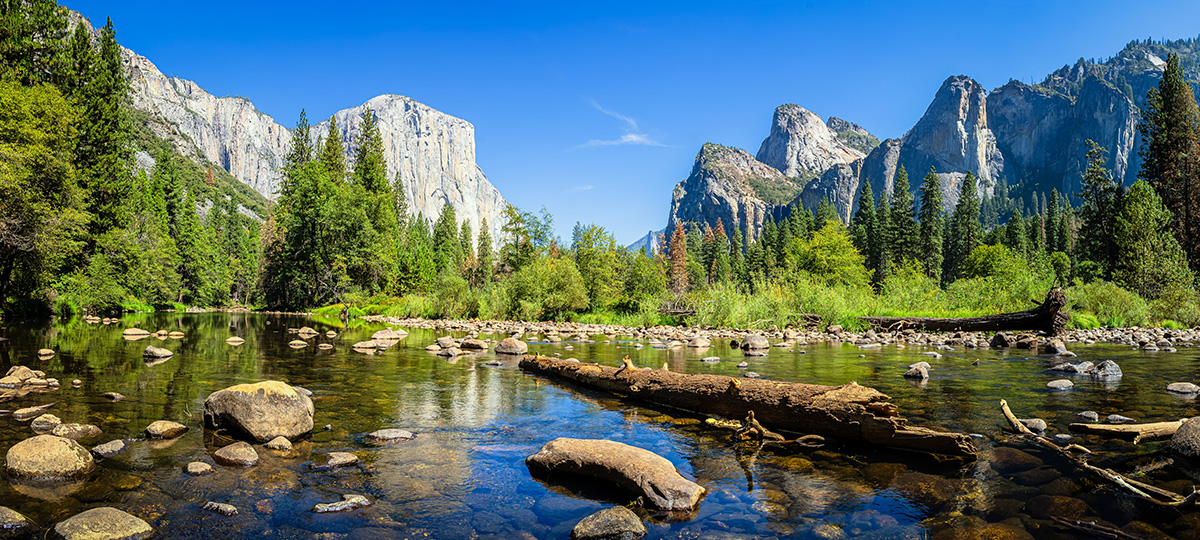
California's National Parks
Yosemite National Park is justly famous for its iconic attractions including El Capitan and Half Dome. The park's waterfalls, alpine meadows, and granite peaks drew early conservationist John Muir to the Sierra Nevada Mountains. His passion for the Yosemite Valley and giant sequoia trees prompted the protection of this area, one of the crown jewels of America’s national park system. Hike some Yosemite’s trails, watch rock climbers on the towering granite cliffs, or gaze in awe at the view from Glacier Point.
Close to the California mainland, Channel Island National Park is 'America's Galapagos'. Explore the sea caves of Scorpion Anchorage, known for its ocean wildlife and giant kelp forests. Walk on stunning beaches. Twenty-five miles off the coast of Santa Barbara, the Channel Islands are home to wildlife including species that don’t exist anywhere else in the world, hundreds of world-class sea caves, mesmerizing giant kelp forests, and a rich, Chumash Native American history. One of the best ways to explore the islands is via a private-guided kayak excursion.
Redwood National Park is home to some of the tallest trees on earth. Redwood National Park is part of three Califoria state parks. Together, these parks protect half of the world’s old-growth redwoods with nearly 40,000 acres of an old-growth redwood forest. Located approx six hours north of San Francisco just shy of the oregon border, making it an ideal stop on a coastal road trip.
Joshua Tree National Park lies in southeastern California, approx. one hour from Palm Springs and 140 miles east of los Angeles. The park features fascinating landscapes and life-forms, including its namesake trees. Other plants and animals call the park home, including bighorn sheep, coyotes and jack rabbits. Joshua Tree is a magnet for hikers, rock climbers, and photographers. Wildflowers in the spring become a major atraction. Joshua Tree is also a magnidficent place for stargazing thanks to the incredibly clear night sky.
Home to some of the tallest trees in the world, Sequoia National Park was established in 1890 to protect the giant trees from being logged. The park is home to the 275 foot tall General Sherman Tree, making it the world's largest tree. Adjacent Kings Canyon National Park was established in 1940 and eventually both parks were linked together, with miles of uninterrupted wilderness trails. Sequoia and Kings Canyon are east of Fresno in the southern Sierra Nevada mountain range.
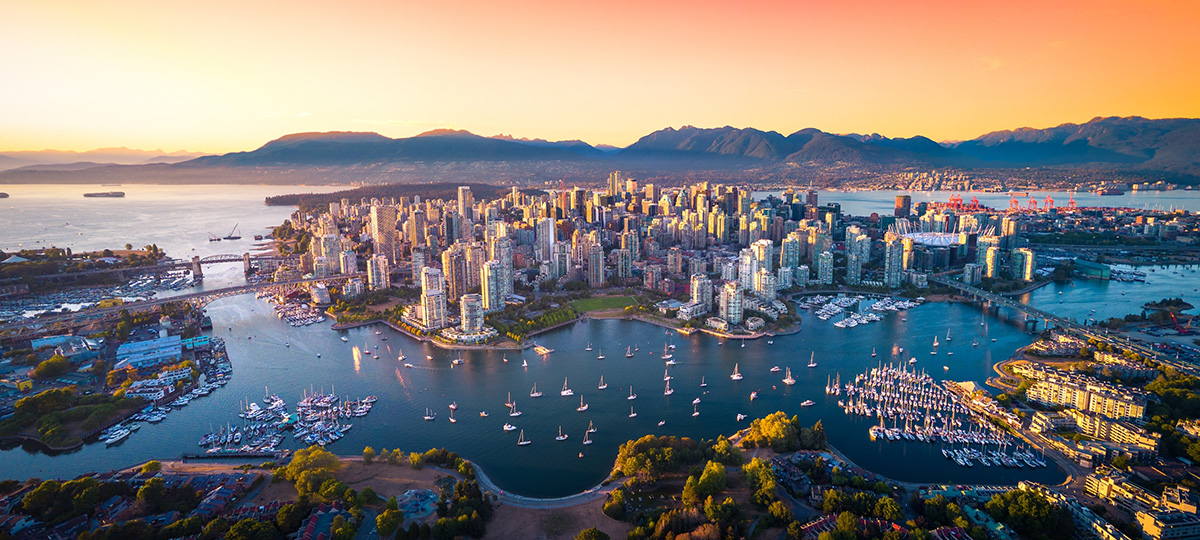
British Columbia: Vancouver, Whistler, and Victoria
Vancouver welcomes you to Canada's most eclectic city, combining urban sophistication and on-your-doorstep wilderness adventure. It is often ranked as one of the world's most livable cities. Set among lush coastal mountains at the mouth of the might Fraser river, Vancouver is rich in both modern and First Nations culture. It is an outdoor mecca for hiking, skiing, kayaking, cycling, sailing, and much more. Magnificent Stanley Park with its iconic totem poles, the brick streets of historic Gastown, and Asian eateries that rival those in the world capitals, are but a few of the many distinct layers of this vibrant city.
Nestled in the rugged Coast Mountains, Whistler offers luxury accommodation, fine dining, and unlimited recreation. At the base of Whistler and Blackcomb Mountains lies the Village, the center of dining, shopping and activity. Over the years, Whistler has been home to the Lil'wat and Squamish Nations, European trappers, and the 2010 Winter Olympics.
Dynamic and diverse, colorful and cosmopolitan, British Columbia’s seaside capital city of Victoria is chock full of walkable attractions and delights. The Inner Harbour is home to horse-and-carriage rides, street entertainers, boutique shops, and whale-watching excursion boats. Victoria’s Chinatown—the oldest in Canada—is a hidden gem. The stunning Craigdarroch Castle, Parliament House, and Victoria Public Market are but a few of the must-see attractions. One can bike, kayak, sail, or whale-watch straight from the city center, and forests, beaches, offshore islands, and wilderness parklands lie just minutes away.

Canadian Rockies: Banff, Lake Louise, Jasper
Banff, a bustling resort town situated in Banff National Park, has a rich heritage as one of the world's most awe-inspiring mountain destinations. Stroll through shops and art galleries downtown, or take in the scenery, which includes jewel-colored lakes, majestic mountains, and the Bow River, from the Banff Gondola. In the evening, Banff comes alive with highly acclaimed restaurants and bars specializing in craft cocktails. Wildlife sightings, including bears in the warm weather months, are common in the Banff townsite and surrounding area. Yoho National Park is located on the west side of the Continental Divide, about one hour's drive from Banff. Named after a Cree expression of awe and wonder, the park lives up to its name. Yoho offers breathtaking scenery with 28 peaks over 3,000m in height. It makes for an ideal day trip from Banff.
Lake Louise is world famous for its turquoise color, the Victoria Glacier, soaring mountain backdrops, palatial hotel, and incredible opportunities for adventure around every corner. In summer, stroll along the lake path or opt for a more challenging hike up to one of two tea houses in the mountains, paddle a canoe or kayak to the end of the lake and keep a sharp eye out for bears, which are often seen on the shore. In winter, it becomes even more beautiful with a coating of snow. Activities abound – ice-skate, snowshoe, and take a sleigh ride to experience the beauty of the region blanketed in snow.
One of Canada's wildest places, Jasper National Park is filled with majestic mountain ranges, crystal-clear blue glacial lakes, towering forests, and abundant wildlife. Located on the eastern edge of Alberta, the park is a magnet for adventurers. Jasper is the largest park in the Canadian Rockies and is part of UNESCO's Canadian Rocky Mountain Parks World Heritage Site, and is home to elk, moose, caribou, and grizzly bears. The park has something for everyone to enjoy, including mountain climbing, water activities, stargazing, and hiking. The town of Jasper provides a convenient gateway to the park. Connecting Banff and Jasper National Parks is the Icefields Parkway, known as one of the world’s most beautiful drives.
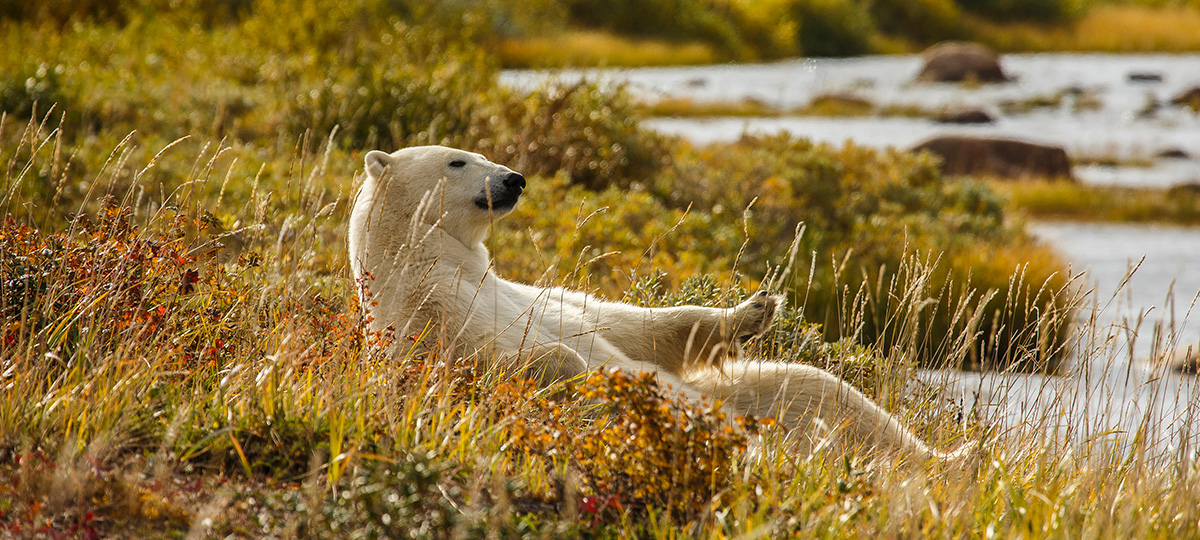
Manitoba: Churchill's Polar Bears & Winnipeg
Experience the character, charm and natural beauty of Manitoba, where no visit would be complete without a visit to the northern region around Churchill, known as the polar bear capital of the world and a world-class destination for wildlife viewing. Churchill is truly remote; in fact, there are no roads that lead here. Coming by plane or train are the only ways to get to this remote town on the shores of Hudson Bay. Situated on the edge of the Arctic, the easiest way to access Churchill is by air, and it’s the perfect place to experience the annual migration of polar bears as well as thousands of beluga whales. Churchill boasts the highest concentration of belugas in the world, typically occuring in July and August. It is also a birder’s paradise. The spectacular Aurora Borealis (northern lights) usually seen up to 300 nights of the year.
While Winnipeg is historically known as Manitoba’s gateway to the North for visitors in search of polar bears and beluga whales, it is a destination stop in its own right. This city of trees is home to the world’s largest collection of Inuit art at Qaumajuq (Kow-ma-yourk); the first of its kind and architectural delight – the Canadian Museum of Human Rights; and a more recent addition, The Leaf – a horticultural attraction celebrating diverse biodomes and butterfly garden. Winnipeg is ideal for walking, and a main attraction the Forks National Historic site, a local’s favorite meeting spot, with indoor market, shops and restaurants. As one of Canada’s most multicultural cities, more than 100 languages are spoken here. It’s a perfect place to learn more about the region’s First Nations heritage and polar bear conservation efforts and celebrate a city that’s focusing on its future while honoring its past.



